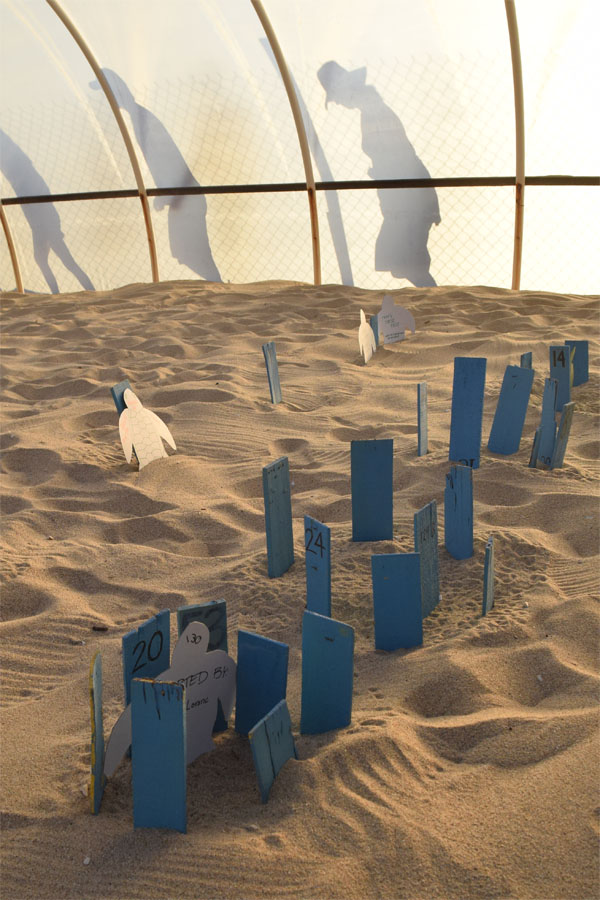

One downside of cruising on the ocean is that our actual travel radius is usually limited to walking distance away from viable anchorages. So in La Paz, we were delighted to find bus services to Todos Santos, an art community on the Pacific side of the Baja Peninsula. Due to steep ocean drop offs and lack of shelter from ocean swells, there are no anchorages or marinas around Todos Santos, and we had to sail right past it on the way down the coast.


For 150 pesos per seat one way, it was a 2 hour ride in an air conditioned bus with in transit entertainment. But for me, rather than watching American actors speaking in Spanish on the screen overhead, I preferred watching the scenery pass by outside, first from touristy La Paz oceanfront, to practical, bustling township, then onto the highway thru desert and ranches with mountains in the background. The bus made stops seemingly in the middle of nowhere, picking up and dropping off ranchers in front of their property.


Todos Santos has a distinctive and pleasant vibe about it. Touristy but not pestering, rural but not desperate, the town center is filled with cute restaurants and charming shops selling artwork and souvenirs. Every corner seems to have been decorated according to someone’s idea of beauty. Tourists and expats outnumber locals and there is a general feeling of relaxation as you walk down the street; everyone is here either to enjoy some art or retire. As with most towns on the Baja peninsula, the main streets give way abruptly to desert surroundings, with a few local houses built on land that was zoned for ranching not many years ago.


Taking an aging taxi out beyond the houses, onto dirt road, we arrived at the highlight of the trip; watching newly hatched baby turtles being released into the ocean. Tortugueros las Playitas organizes a volunteer run turtle rehabilitation program on the beach. Nestled among rustic hotels and beach houses, their plastic sheet greenhouse occupies a small patch of sand where turtle eggs are brought in and reburied behind fences. Volunteers come out at night and watch pregnant turtles come in to lay their eggs. Once the nest is dug, the turtles go into a sort of trance, and the volunteers can catch the eggs as they are being laid. Round and soft as ping pong balls, they are then reburied in the greenhouse until they hatch. Here, they are safe from predators such as birds, and human interference, such as people driving their vehicles on the beach. This time of the year, temperatures are also so cold that eggs rarely hatch. In the warm greenhouse, the only temperature choice to be made is whether the turtles hatch male or female. 3 species of turtles can be found on the beach here; Leatherbacks, Blacks and Olive Ridleys, although the first two species are so endangered that the center only receives Olive Ridleys with any regularity. Turtles remember the beach on which they were born, and return to the same one to lay their own eggs. Thus, in places around the world where beaches have been overdeveloped; for example by having been turned into marinas, returning turtles are unable to find a spot to lay their eggs. Nobody knows what pregnant turtles do in such situations.


When the volunteers arrive that evening, we are allowed into the greenhouse to see how the incubating eggs are buried. Names of sponsors are planted in the sand next to their chosen nest; families with children using this experience as a science field trip, tourists enriching their travel experience, and general do-gooders. Today, they had a tub of about 20 wriggling hatchlings to release, yesterday there was only one. As we waited for more visitors to arrive, we sat in the sand and chatted with another group of visitors, one of which was celebrating his birthday that day; the same birthday as our turtle hatchlings. They were a group of American retirees who bought a house on this beach several years ago when the local government allowed ranchers to sell their land for housing developments. They described happening on Todos Santos while on vacation, and falling in love with the charming town, then building their house on what used to be unpaved desert brush with no electrical services, intermittent water supply, and working with a crew of builders that only spoke Spanish. It was an adventure of a lifetime for them and they still loved the tiny town, but now it was time to move back to America to be closer to their children and watch their grandchildren grow up.


As the sun set, volunteers brought out the tub of hatchlings to be released, surrounded by 50 or so visitors. Although dusk is believed to be the safest time for baby turtles to run to the sea as predatory birds have their own predators to flee from, we couldn’t help feeling concerned for these tiny new ones as they were set loose into the darkening night, giant waves washing them back at each attempt to reach the water. What were these tiny babies going to do once they were in the ocean? Did they know where to go to rest or hide from predators? We spent 15 minutes watching the turtles making painfully slow progress into the surf, cheering as each one got its first dip into the Pacific. Who knows how many will survive to adulthood? Maybe not all of them, but at least they were given a better chance so far.


Returning to the boat way after dark, we felt grateful for the existence of bus services. Funny as it may sound, cruising finally felt like it was giving us the opportunity to travel as much as we want to. As we tucked in an exhausted Rowan into bed, we pulled off his shoes, dumping a pile of beach sand all over the floor. That is how we know that it has been a fun day for everyone.
Visit Tortugueros Las Playitas’ website to learn about their conservation efforts. http://www.todostortugueros.org/
